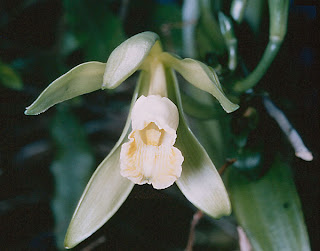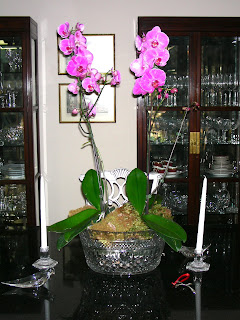

Polyrrhiza lindenii [Dendrophylax lindenii (Lindl.) Benth. ex Rolfe]...
Native to Southwest Florida and Cuba.
In Florida, the range is localized in swamps in the Fakahatchee, Big Cypress and Corkscrew areas...
Found on trees, including pop ash, pond apple, bald cypress, maple, and oak in hardwood hammocks, sloughs and cypress domes.
... Blooms appear May through August, although occasionally in other months; heaviest blooming is in July. Typically the plant has one or two blooms, but there can be as many as 10. Individual blooms last 10 to 14 days.
... Pollination is done by the giant sphinx moth.
.., The ghost orchid got its name because the plant has no leaves ? only roots ? and when it blooms, the flower seems to float in mid-air.
...
The highest known location of any ghost orchid in Collier County was in Fakahatchee Strand State Preserve, the orchid capital of North America, at
23 feet; the Corkscrew orchid was 45 to 50 feet above the ground.
... the Corkscrew orchid bloomed three times between July 7 and Oct. 15.
... Usually, one or two blooms appear; the Corkscrew orchid had 12 flowers
the first time it bloomed, 10 the second and three the third."
URL :
http://www.news-press.com/apps/pbcs.dll/article?AID=/20071229/LIFESTYLES/71228073/1075
photo : [caption : A... ghost orchid... on a bald cypress tree at Corkscrew
Swamp Sanctuary...
Sanctuary officials believe the flower is between 20-30 years old...]
"the Fakahatchee Strand...
a wild orchid clinging to a branch.
... said state park guide John Elting. "That's a clamshell orchid blooming..."
rare ghost orchids and ribbon orchids.
...
Wild orchids draw some of the visitors to the Fakahatchee Strand...
The Fakahatchee Strand lies west of the Big Cypress National Preserve and Everglades National Park. A strand is a narrow slough, pronounced "sloo," where trees grow along a natural depression. Park rangers joke that the Fakahatchee is "the Grand Canyon of the Everglades," even though it's only a few feet deeper than the areas surrounding it.
Beginning in World War II, the giant cypress of the Fakahatchee were logged for shipbuilding and construction. Millions of feet of timber were cut in
the 1940s and '50s. Small railroad tracks carried logs out of the swamp. The ridges that supported those tracks still line the strand.
...
The 90,000-acre swamp gained fame in "The Orchid Thief," a 1998 book by Susan Orlean. Her story of an... orchid poacher became a... 2003 movie
under the name "Adaptation." Orlean described the Fakahatchee as "beautiful the way a Persian carpet is beautiful: thick, intricate, lush, almost
monotonous in its richness."
Elting loved the vivid storytelling and painstaking research of "The Orchid Thief," but said Orlean didn't care for being in the swamp. She didn't take
the wading tour."
URL :
http://www2.tbo.com/content/2007/dec/27/me-swamp-tour-a-slip-back-in-time/
http://cmsimg.news-press.com/apps/pbcsi.dll/bilde?Site=A4&Date=20071229&Category=LIFESTYLES&ArtNo=71228073&Ref=AR&Profile=1075&MaxW=290
Sincerely,
Steve Peralta
http://www.1888orchids.com/
"the Fakahatchee Strand Preserve State Park in southwest Florida.
... has been the scene of numerous orchid thefts...
park biologist Mike Owen...
lead[s]... group of orchid enthusiasts... during a four-hour swamp walk.
more species of orchids... grow wild here than anywhere else in the country...
There are 315 ghost orchids scattered across the Fakahatchee's 85,000 acres, according to Owen... They don't bloom until summer...
The park offers these Saturday tours during Florida's November to April dry season, when the orchids are easier to find.
The park lies about 70 miles west of Miami, across the Miccosukee Indian Reservation and a five-mile stretch of road...
The Fakahatchee is part of the Everglades ecosystem that streams down from Lake Okeechobee to the Florida Keys. It's the largest strand swamp in the world [really ?]: a 19-mile long channel cut 2- to 3-feet deep into a limestone bed over more than 5,000 years. Low streams called sloughs flow throughout the strand...
[Owen's ] notes document the locations and conditions of endangered plants; some... are growing where previous orchids were stolen... come across a ghost orchid, it will get a detailed entry - how many roots it has, how high off the ground it is and other remarks on its health.
...
our first orchid... flat green roots of a ribbon orchid...
a blooming orchid that Owen calls the "roller coaster orchid." "flowered star orchid," he says...
Owen temporarily stopped taking tours into this particular slough after several orchids went missing.
He's overjoyed to find tiny helmet and night-scented orchids growing in a blank patch in the moss on a tree - the scar of an orchid theft.
Their remote habitat and fear of the unknown protect the orchids that remain from all but the most determined thieves, Owen says.
...
After more than three hours in the water, we've seen 10 different orchid species on this walk - but not the ghost orchid....
Owen's hands suddenly go up in victory. A thin green ribbon with white dash lines appears to be tied around the rough bark of a pond apple tree. It's a young ghost orchid.
...
Orchid nurseries famous in the state... can't grow these delicate plants...
Ghost orchids restrict themselves to very specific growing conditions, pollinated by just one species of moth...
Owen is encouraged to find three active growing tips... and deems the plant generally healthy. He's been watching it since 2003, and guesses it could
be another decade before it blooms.
...
The park is about a two-hour drive west of Miami and is located just west of Copeland...
Swamp walks last about four hours."
URL : http://www.miamiherald.com/775/story/430075.html
The elusive plant was the subject of the best seller The Orchid Thief and its movie spinoff, Adaptation, which charted the sometimes-bizarre world of orchid enthusiasts. There are believed to be about 1,000 ghost orchids in southwest Florida, but few are easily accessible, and their whereabouts are kept under wraps to protect them from poachers.
But the Corkscrew Swamp specimen is within 100 feet of a visitor boardwalk and visible with a spotting scope. Even better, the plant produced 12 flowers in a single blooming last year — unprecedented, says executive director Ed Carlson. Blooms typically last three weeks, but last year this plant blossomed three times into September. Tourism types are keeping their fingers crossed.
http://www.usatoday.com/travel/destinations/2008-06-26-florida-ghost-orchid_N.htm?csp=34



















